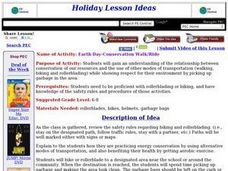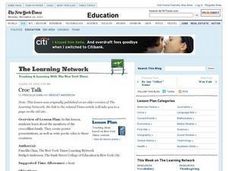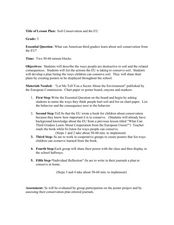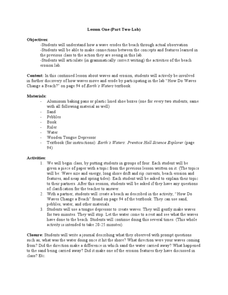Curated OER
Dishing the Dirt Part 2
Students explore the differences between specific soil characteristics. They participate in an experiment in which they discover soil texture. They write their observations in a journal.
Curated OER
Earth Day-Conservation Walk/Ride
Students explore the relationship between conservation of our resources and the use of other modes of transportation (walking, biking and roller blading). They show respect for their environment by picking up garbage in the area. They...
Curated OER
Croc Talk
Students investigate and study about the members of the crocodilian family and then create poster presentations and write poetic odes to them. They distinguish between facts and myths about crocodilians and assess the new discoveries...
Curated OER
What can American third graders learn about soil from the European Union
Third graders develop a list of ways humans destroy soil. In this soil conservation lesson, 3rd graders listen to a book on soil conservation and design posters about how to conserve soil. Students share their work orally with classmates...
Curated OER
Local and Global Impacts
Students conduct an interview with Dr. Hajo Eicken to discuss local and global impacts. They hold an audio conference to ask about characteristics of the Arctic environment, climate, climate change, the greenhouse effect and global...
Curated OER
How Do Waves Change a Beach?
Students conduct an experiment on beach erosion. In this earth science lesson plan, students create a beach model and use tongue depressor to produce waves. They write a journal about their observations.
Curated OER
Worms Attack
Fourth graders observe earthworms and record their observations. They test to find how earthworms react to touch and moisture. After their study of earthworms, they do a creative writing activity in which they tell about life from the...
Curated OER
Ask the Antlion
Pupils observe and examine the life cycle of antlions, recording their observations of the live insects in a journal. They view an antlion on a video microscope, draw the body parts, and replicate their experiment at home.
Curated OER
Air Pollution: Visible And Invisible
Fourth graders observe air pollution that is visible and invisible with experimentation. During the experiment the students collect data that needs analysis. The observations are recorded in the lab journal. The data also is represented...
Curated OER
Thanksgiving: Bird Evolution
Students explore the evolution of birds. In this biology lesson plan, students research articles that discuss evidence about the ancestry of birds. They discuss their findings with the group and draw a journal magazine cover highlighting...
Curated OER
Ice Core Research
Students study the work of Dr. Hajo Eicken through an audio conference. They engage in a conference call with Dr. Eicken to identify how ice core research is designed and conducted. After asking Dr. Eicken questions, they record their...
Curated OER
Dog Salmon Lesson Nine
Middle schoolers culminate the Dog Salmon Unit by writing a one page paper on their reflections and experience. They synthesize the Athabascan terms for the salmon parts.
Curated OER
Gray Whales
Pupils listen to the book, Lagoon Tour: Whale Watching at Laguna Ojo de Liebre and discuss the photos, vocabulary and captions. They create a scrapbook, tourist brochure, travel journal, or a song about whales.
Curated OER
Butterfly Life Cycle
Third graders investigate the life cycle and development of butterflies. They complete an online WebQuest, and write journal entries about their research information. Students create a poster, and observe real Painted Lady larvae...
Curated OER
Be the Kiwi: What is going on in New Zealand?
Students study the three environmental issues facing New Zealand today. In this ecology lesson, students brainstorm some solutions to these environmental issues. They share what they have written in their journals.
Curated OER
Balancing Bottles
Students explore the Law of Conservation of Matter using effervescent tablets. In this mass and energy lesson, students investigate how mass is conserved in the reaction of effervescent tablets and water. They will discuss and...
Curated OER
Become a Member of the Mission to Mars Team
Students examine the various jobs of the Mars Mission Team, organize them into categories and write a formal application for a position on the Mars Mission. Entries are made into the logbook and on-line Field Journals read.
Curated OER
What's In the Dirt?
Third graders watch a demonstration and write in their journals their predictions about how time might affect the moisture in the two paper towels. Using a Berlese funnel, they record their observations when it comes the amount of...
Curated OER
Water and Ice
Students study the water cycle and states of matter. In this water cycle lesson, students observe ice for a period of time and record their observations. Students create a Venn Diagram comparing water in solid form and liquid form....
Curated OER
Water Quality
Students play the role of scientists testing for water quality in the area. In this ecology lesson, students determine the water sample's pH, temperature, dissolved oxygen and turbidity. They write a journal reflection after the activity.
Curated OER
It’s Your Trash!
Students identify the different sections of a landfill. In this ecology lesson plan, students brainstorm ways that they can help in proper trash disposal. They write a reflection journal about their thoughts on the subject.
Curated OER
Gasping for Truth
Twelfth graders investigate global responses to fighting the spread of severe acute respiratory syndrome, then write a news report for people in their region of study.(April 3, 2003)
Curated OER
The Life Cycle of the Butterfly
Students examine the life of a butterfly. They write a biography from the point of view of a caterpillar using new vocabulary. They use magnifying glasses to examine butterflies and caterpillars.
Curated OER
From Seed to Plant
Pupils adopt seeds, recording their observations as they draw their seeds, germinate them, and plant their seedlings using the hydroponic method. Students maintain journals recording their germination experiments.























